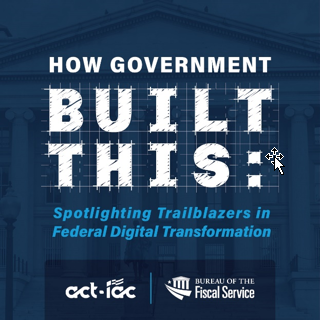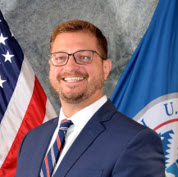

‘How Government Built This’ Innovation Spotlight: From Transformation to Evolution – How DHS Focuses on Strategic Partnerships to Jumpstart Digital Transformation

Welcome to “How Government Built This,” a six-part podcast and blog post series developed by the Department of the Treasury’s Bureau of the Fiscal Service Office of Financial Innovation and Transformation (FIT) in collaboration with the American Council for Technology and Industry Advisory Council (ACT-IAC) a non-profit educational organization established to improve government through the effective and innovation application of technology. This series spotlights trailblazers in Federal digital transformation. Resources and links mentioned in each podcast will also be available at actiac.org/thebuzz.
Dave Larrimore and Rob Brown
 Mr. David (Dave) Larrimore serves as the Executive Director of the Chief Technology Officer Directorate for the Department of Homeland Security (DHS) Office of the Chief Information Officer (OCIO).
Mr. David (Dave) Larrimore serves as the Executive Director of the Chief Technology Officer Directorate for the Department of Homeland Security (DHS) Office of the Chief Information Officer (OCIO).
As Executive Director, Dave is responsible for determining the future of systems across the entire DHS portfolio of national security missions. He leads a team of experts engaged in enterprise architecture, digital innovation, emerging technologies, and IT program delivery, oversight, and governance.
Dave has over 15 years of experience in federal IT and has dedicated his professional career to leveraging technology to build and transform organizations.
Before joining OCIO, Dave served as a Lead Solutions Engineer in the Global Public Sector business unit of Salesforce, Inc., where he used design thinking to reinvent how Solution Engineers build, tailor, and deploy assets to be shared by every role in the organization.
Dave also served as the Chief Technology Officer for Immigration and Customs Enforcement (ICE). In that role, his team led the work to deploy the organization's first multi-cloud environment, providing not only transparency and cost savings, but doubled project teams speed to deliver mission value.
Before his time at ICE, Mr. Larrimore served as a Cloud Strategist, where he helped bring cloud technology to the Department of Agriculture and built the first Enterprise Data Warehouse for the General Services Administration.
 Mr. Robert (Rob) Brown serves as the Chief Technology Officer (CTO) at DHS’s U.S. Citizenship and Immigration Services (USCIS).
Mr. Robert (Rob) Brown serves as the Chief Technology Officer (CTO) at DHS’s U.S. Citizenship and Immigration Services (USCIS).
As CTO, Rob has focused his work on cloud adoption, DevSecOps and data as a product. An open-source advocate, he’s worked with other DHS agencies on code and data collaboration. At the same time, USCIS created its first enterprise data lake under Rob to end duplicate data and make it easier for machine learning models to support the immigration mission. Rob spearheaded a Domain Driven Design and Eventing evolution to digitize manual, paper-stricken processes and antiquated technology at USCIS.
Rob thoroughly understands IT and business, leading to successful experiences in finishing large scale IT deployments from the corporate IT strategy and vision to design, build and maintain. Rob focused on Domain Driven design, Event driven architecture and reactive micro services for the past 5 years. Rob has also been working to provide BizDevSecOps technical standards and governance at USCIS. He has expertise in auditing, directing, and managing corporate IT strategies for small to large sized commercial businesses. Also, Rob has a strong background in software development, health care, scientific research, and biomedical industries.
Why is digital transformation more than just advancements in technology?
Dave stated that digital transformation is something we have all grown up with and is something that is a part of everyone’s vernacular since information technology (IT) came around. Rob suggested the word “transformation” may be reconsidered for the word “evolution” since transformation sounds like it has an end point.
What inspired your organization to take on a digital transformation and how have emerging technologies helped enable that transformation?
Dave highlighted that his original inspiration came from serving as a component Chief Technology Officer (CTO) and what comes with seeing the forest for the trees. Today, the Department of Homeland Security (DHS) oversees areas include disaster recovery, presidential protection service, and Federal air marshals and all these areas require different technologies.
Dave said that at the Department level, DHS is working to understand all these technologies and apply proper governance and oversight, share best practices, and build communities of practice around Agile, DevOps, and cloud practices.
Rob said that the United States Citizenship and Immigration Service’s (USCIS’s) mission helps drive transformation and set the mindset for backlog reduction, cybersecurity, data sharing, and mobile or decentralized identification. Rob noted that the mission space is tactical and rewarding both in serving U.S. citizens and non-U.S. citizens.
How did your organizations decide where to start first and how do you see things changing over the short term compared with the long term?
Dave stated that several Executive Orders (EOs) including the cybersecurity, Artificial Intelligence (AI), and customer experience EOs set the priorities. With these, the Department is using maturity models to identify milestones across the enterprise. AI and Machine Learning (ML) are key to this and building out a use case inventory will support this to help define guidance and structure for these different areas to help inform organizational culture.
Rob mentioned that USCIS has many initiatives under way and there were challenges with customer service, resource mapping, product management, and product hygiene. Rob mentioned there was much work being done in silos as well. Considering this, Rob’s team took an academic approach and started using an Inverse Conway Maneuver to help break down silos. Rob highlights that communications patterns show what has been built and using this information, the team was able to identify areas for enhancing these siloed areas.
Following this approach, Rob’s team has adopted a new domain driven design which is now covered in their governance approach across the enterprise which lends to a more holistic perspective. Rob’s team now tracks reduction and redundancy across IT more readily, the enterprise services are now satisfying several business directorates, and there is greater insight into resource management and cost savings. Automation has also been key to this especially when it comes to data products and increasing efficiencies.
How has your organization identified the proper maturity models to use?
Dave said that when a specific area reaches a point where it requires management oversight, DHS then starts following the appropriate maturity model. For example, cloud technologies may require self-provisioning, an Authority to Operate, and the like, and at the Department level the maturity model is more focused on the management competencies. So, in applying the maturity model, Dave will ask questions such as:
— How many cloud platforms does a component have?
— Are best practices being implemented around cost savings?
— Are the contracts flexible?
The maturity model is then run through the CTO council for feedback and an assessment is conducted. From there, Dave’s team assesses whether the mission need is being addressed, if there is sentiment analysis conducted or self-servicing capabilities, how the technologies been used, whether each component has proper management and oversight, and whether the component has a strategy or path forward. This feedback helps identify any blockers, external dependencies, and budgetary issues to better understand what things can be codified, what requires further investment, and what can be scaled across the components.
Rob said that the domain driven design was executed through software concepts first by identifying personas and user types that interact with USCIS to allow a logical breakdown of the domains based on the business capabilities and functions required by the different personas. Then workflows were developed to cut redundancies. This helps bring the right people together and build a common lexicon through manifesting the domains for building successful digital products.
How can organizations prepare the workforce and teams at all levels to embrace change during digital transformation initiatives?
Dave said things are constantly changing and to address this DHS introduced forums where there are opportunities for greater discussion. This includes educational components, technology talks, and inclusivity approaches instituted across the enterprise to help people learn new things in different subject matter areas. Dave noted that program and product hygiene inform these initiatives to determine what is feasible for the organization from an implementation perspective. Dave noted this sometimes means that if something goes on the list, something else will have to come off the list.
Dave stated that instituting a live percentage of real cycle time or work, such as a sprint, can help with assessing these areas to make informed decisions. Rob explained that developing relationships across the enterprise founded in transparency and collaboration helps break down silos to identify and address challenges.
How is Diversity, Equity, Inclusion, and Accessibility (DEIA) integrated across your transformation initiatives?
Dave highlighted that DEIA has the internal and the external side, with the external side being focused on American customers and citizens. Dave expressed that the external starts with the internal. DHS headquarters uses human resources and hiring strategies to access diverse talent to lead a diverse workforce which COVID helped to inform. Dave noted that his connection to the internal gives a greater perspective into the customer.
What are the challenges an organization may face in adopting new initiatives? How do you overcome these challenges?
Dave highlighted that he has an immense responsibility to all DHS’s acquisition programs which requires working with programs across the Department to encourage them to take on these initiatives. Dave noted that while his role has authority, this doesn’t mean it needs to be the method of choice.
Dave said those programs need time to explain their stories allowing him to develop a new strategy in six months to sculpt a message and work more closely with the DHS programs. This is one of Dave’s biggest lessons learned. Rob stated that bringing people together and building coalitions is much of the job internally and externally. Rob said that it comes down to being transparent, collaborative, listening, and encouraging others to speak up.
How can organizations transform at scale?
Dave stated that transforming at scale requires good communication since many groups across the enterprise are not talking to each other. There is a lot that can be shared across different teams and the richest asset is the people. Dave mentioned his team used to focus on the components, but now focuses on the problems the components bring forward. His team talks about the problems, including customer experience, zero trust, and cloud and it has informed guidance, playbooks, and several other initiatives for driving best practices.
Rob noted that the technologies have sometimes been implemented in a “storming the beach” fashion, requiring more coordination especially for skill sets. Rob said that USCIS has focused on autonomous services which can be used by the business teams for economies of scale. Rob highlighted that these types of foundational platforms can democratize technologies for everyone.
Advice for readers
Dave said that headquarters is not meant to be the top of the pyramid, but the foundation. There are many demands placed on the Department and so to do the job right you need a mindset of change. Dave stated that by serving as a foundation for change, the components can move faster.
Rob echoed a similar sentiment and recommended focusing on people and transparency to encourage productive discussions across the organization rather than hierarchical communications. Rob also recommended not to be afraid to try new technologies and build coalitions around them.
References
- For more information on ACT-IAC’s Emerging Technology Accelerator, please reach out to Jackie French at jfrenc27@alumni.jh.edu.
- ACT-IAC Federal Insights Exchange (FIE) panel covering “Customer Service Executive Order at the Department of Homeland Security” taking place virtually on October 4, 2022, from 10 AM to 11 AM.
- ACT-IAC Emerging Technology Use Case Summit taking place on September 20, 2022, in person and virtually from 9 AM to 12 PM
